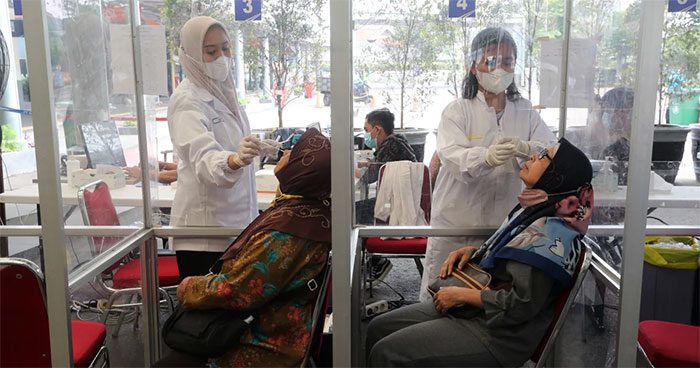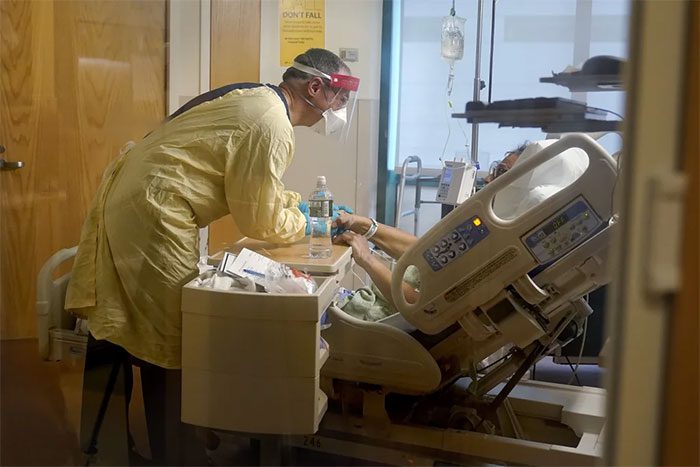The BA.2 subvariant of Omicron has emerged in many countries and territories. Notably, this variant is predominant among new cases in various locations.
According to information from the Director of the Ho Chi Minh City Department of Health, Tang Chi Thuong, random screenings revealed that 64% of positive samples for Omicron in Ho Chi Minh City were the BA.2 variant – also known as “stealth Omicron.”
In Hanoi, Omicron has been detected in 20 out of 30 districts and towns; among these, the BA.2 variant accounts for up to 87% of the total samples identified as Omicron variants.
This variant is also rapidly spreading in several states across the U.S. and other countries around the world, gradually dominating new cases. Numerous studies indicate that “stealth Omicron” spreads quickly and may cause more severe illness, increasing the risk of reinfection with COVID-19.
Faster Transmission Than Original Omicron Variant
The Omicron variant is currently the most widely spreading strain globally, accounting for the majority of gene sequences reported to GISAID.
According to virologist Trevor Bedford from the Fred Hutchinson Cancer Center in the U.S., BA.2 has been found in 82% of infections in Denmark, 9% in the UK, and 8-10% in the U.S. These figures are based on data from GISAID and the University of Oxford.
Currently, at least 69 countries and territories have reported BA.2 infections. According to the latest report from WHO, India, China, Pakistan, Bangladesh, Denmark, Nepal, Brunei Darussalam, Guam, Montenegro, and the Philippines have reported BA.2 as the dominant strain in new cases. South Africa, the UK, Denmark, and the U.S. have also seen an increase in BA.2 infection rates. Southeast Asian countries report a BA.2 prevalence of 44.7% among Omicron infections, while the Americas report about 1%.
In the UK, preliminary analysis tracking epidemiological history from December 27, 2021, to January 11, 2022, by the UK Health Security Agency shows that the transmission level in BA.2 infected individuals (13.4%) within households is higher than that of other Omicron subvariants (10.3%). The agency found no evidence of differences in vaccine effectiveness.

The rapidly spreading Omicron variant is dominating new cases globally. (Photo: Bagus Indahono/EPA).
Omicron has several subvariants such as B.1.1.529, BA.1, BA.2, BA.3, and the World Health Organization (WHO) is monitoring them. Among these, BA.1, BA.1.1 (Nextstrain clade 21K), and BA.2 (Nextstrain clade 21L) are the most common. At a global level, gene sequencing shows that BA.2 infections have increased compared to BA.1 in recent weeks.
BA.2 differs from BA.1 in several genetic sequences, such as amino acids in the Spike S protein. BA.2 is also referred to as “stealth Omicron.” This is because it lacks a specific genetic change that allows rRT-PCR tests to have initial indicators.
In a study published on bioRxiv on February 17, by a team of experts at the University of Tokyo, Japan, it was found that BA.2 can replicate in cells faster than BA.1 – the original version. Its ability to adhere to cells is also quicker and more adept. This allows the virus to create larger cell clusters (syncytia) than BA.1. Experts also assess that BA.2 spreads 40% more effectively than the original Omicron strain.
According to the Statens Serum Institut (SSI), Denmark’s leading infectious disease authority, preliminary calculations suggest that BA.2 may be 1.5 times more infectious than BA.1. However, the agency’s initial analysis shows no difference in hospitalization risk between these two variants.
Meanwhile, according to WHO, initial data indicate that BA.2 “appears to be more transmissible than BA.1” and they are conducting further studies to determine the cause. “However, the infection rates of all variants globally are trending downward,” the WHO report dated February 22 states.
Does Stealth Omicron Cause More Severe Illness?
According to a study by Japanese experts in February, the most concerning aspect of BA.2 is that the syncytia formed later will become factories for replicating the virus. Delta had previously shown a strong ability to create syncytia in the host’s body. This is the reason the virus devastates the lungs of patients quickly and severely.
The expert team infected guinea pigs with BA.2 and BA.1; those infected with BA.2 became more severely ill, and their lung function deteriorated more significantly. Meanwhile, the tissues and lungs of guinea pigs infected with BA.2 were more damaged than those infected with BA.1.

WHO asserts there is no evidence that BA.2 causes more severe illness. (Photo: Washington Post).
Meanwhile, based on available data on transmission, severity, reinfection, diagnosis, treatment, and vaccine impact, the WHO expert team confirms that BA.2 does not cause more severe illness than Omicron. They also emphasize that BA.2 should continue to be monitored by public health authorities as a subvariant of Omicron.
Dr. Maria Van Kerkhove, head of the WHO’s COVID-19 Technical Team, stated: “We do not see a difference in severity between BA.1 and BA.2. Therefore, the virulence-related hospitalization risk is the same for both. This is very important as many countries are experiencing a surge in cases of BA.1 and BA.2.”
WHO’s conclusions will help countries like Denmark, South Africa, and the UK, where BA.2 is spreading rapidly, take appropriate response measures.
Resistance to Vaccine-Induced Immunity
According to research from Japan, similar to the original Omicron variant, BA.2 has the ability to break through antibodies in the blood of vaccinated individuals. It can also resist natural antibodies from people previously infected with other variants such as Alpha and Delta. Notably, BA.2 is nearly completely resistant to certain monoclonal antibody treatments.
BA.2 also shows resistance to some common treatments such as sotrovimab, a monoclonal antibody used against Omicron.
Like Omicron, the BA.2 subvariant contains mutations that can evade the immunity generated by vaccines. Booster shots are effective in preventing 74% of symptomatic infections.
A new study from the UK Health Security Agency shows that the vaccine’s effectiveness against symptomatic COVID-19 from BA.2 is 70%. This figure for BA.1 is 63%.
Another study from Michigan State University, USA, reviewing various findings on BA.2 concludes that it will gradually dominate due to its ability to “infect antibody-naive populations.” Notably, BA.2 has been found to have over 30% higher vaccine resistance compared to BA.1 and 17 times the resistance compared to Delta.
Preliminary research indicates that one of the two monoclonal antibody treatments authorized for use against Omicron is ineffective against BA.2. However, the manufacturer of the Eli Lilly monoclonal antibody asserts that their new treatment is effective against BA.2.
Regarding the risk of reinfection with COVID-19, preliminary information from Denmark indicates that reinfection with BA.2 in individuals previously infected with Omicron is not common. Most symptomatic patients have mild symptoms and are primarily those who are unvaccinated.

















































